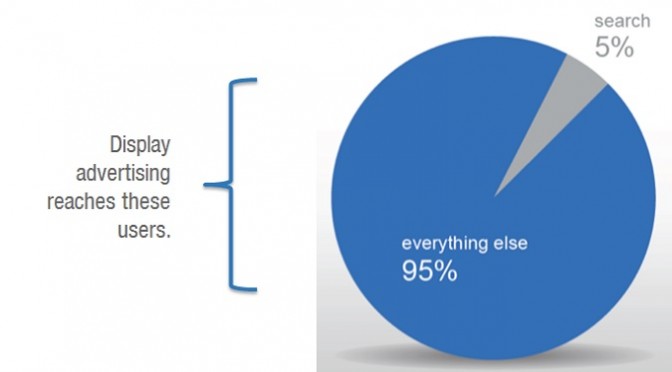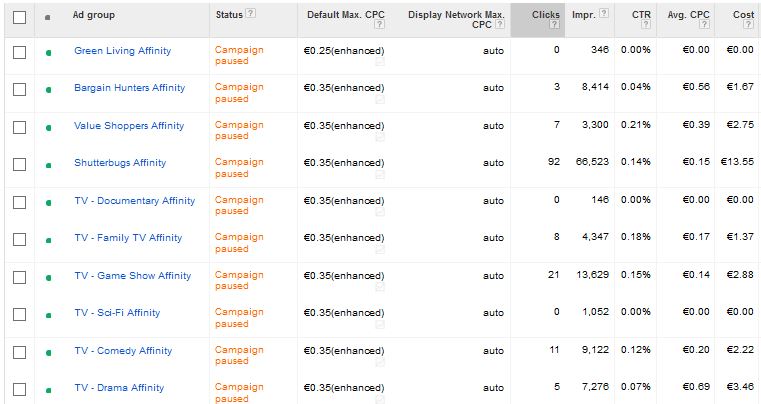Data Puke
Bounce Rate Puke
Avinash Kaushik is nuts.

Data Puke
Bounce Rate Puke
Avinash Kaushik is nuts.

The Google Display Network is a very powerful tool to reach potential customers when they may not be aware or actively seeking your offering. However it behaves very differently than search especially in the realm of keywords.
A trap to be avoided is to start with search campaigns and simply copy the campaign and switch the network targeting. This is not the best way to create contextual keyword display campaigns as Google looks at total ad group themes to decide where to place the ads.
Secondly, there are keywords that you would rarely have in your search campaigns. Wide keywords that are loosely related to the product, have massive search volume, low conversion rates and high CPCs. All the things that make a performance search campaign under-perform. Not so in display. If Google looks at your ad group in its entirety and will match your ads to articles/content that are most closely related to the overall theme, then you need related keywords in your ad group to tell Google where to serve your display ads.
Think of ad groups as summary points of content. Your keywords are the bullet-points of all the key concepts within the article. Basically your campaigns will be made up of a number of ad groups each of which are mini synopses (yep that’s a plural) of the main points of the content you wish to target.
Another thing to consider is that keyword duplication across your account behaves very different to that of search. As we know, duplicate keywords in search can be a major cause of CPC inflation and poor performance. As before, this is not the case in display. In fact multiple instances of the same keyword across the display campaigns lead to different targeting outputs, as the combination of keywords within an ad group will vary.
So if you have 2 ad groups, one for Apple iPods and one for Apple iMacs, both ad groups can contain the keyword ‘apple’. Depending on your website, product range and objectives you can negate certain keywords from across ad groups, ie. add ‘ipod‘ as a negative keyword to the iMac ad group and vice versa.
Likewise keyword match type isn’t a consideration for positive keywords on the Google Display Network – all keywords are on broad match. However, negative keywords behave as they do in search campaigns.
So once you know how Google reads and serves ads on the Google Display Network you can enlist your creative powers to combine the top theme variations of the content you wish to serve your ads alongside. It’s a challenge to summarise the points of your ideal content mix. Choose key conversion or awareness focused keywords, depending on your campaign goals. Think: what are the 5 keywords that summarise the content I want to be associated with? What do the experts in this field talk about, what words do they use? It’s like reverse onsite keyword optimisation in the world of SEO – so think ‘what would I do if I were the Googlebot?‘
Then try differing combinations of keywords to test how ad group variations perform. Note: don’t just change one keyword, change the broader theme of the ad group from information to review keywords to purchase drivers etc. Change the philosophy of your targeting to test the results & performance.
Following on from keyword choice, structuring your ad groups and campaigns will allow for efficient and effective management of the performance. It’s recommended that ad groups are limited to between 1 and 50 keywords. I can’t emphasise enough how large ad groups are totally ineffective and un-targeted and should be avoided. Keep the ad groups to 1-10 contextual keywords.
The Display Planner allows you to estimate your search impressions and it is advisable to keep ad groups with lots of potential impressions in campaigns on their own so you can control the daily budget of the high volume ad groups. Secondly this allows your lower volume ad groups to serve without their daily budgets being affected by ad groups which spend a lot more.
By looking at display keywords as bullet points and ad groups as themes, you can test performance and serve Google Display ads more effectively alongside content that is more related to the topics you want to be associated with.
It’s very important to treat search and display campaign builds differently, ie. keyword choice, duplication and match types. Expected ad group traffic volume from available inventory should influence campaign structure, with high traffic ad groups being housed separately to lower traffic ad groups for budget reasons.
As with all digital advertising, testing is key. Try different keyword combinations, make sure there is sufficient difference between your ad groups for clearer test results; drive scale in what performs and pull back n what doesn’t.

One of the most powerful free tools in any digital marketers inventory is hidden away in the basement of Google. Released back in 2012, I’m amazed to hear that many people still don’t use Google Tag Manager.
Google Tag Manager gives you full control of what tags you can use on a website without ever having to contact a Webmaster to get it added! Here’s the official Google Video from 2012:
So, no more calling IT to get an AdWords conversion code, Google Analytics custom line, AdRoll Pixel or any other kind of hard-coded tracking implementation. Tag Manager allows you to add any tag to a website remotely, saving time and increasing flexibility with product innovations like Dynamic Product Listing Retargeting etc.
In actual fact, there is one piece of code to implement, then you’re in the clear. When you create a Tag Manager account you have to create what’s called a container. This is where the tags live. This container has an iframe tracking pixel which is pasted just after the opening <body> tag on every page of your website. There is no need to modify this iframe code just paste it on the site and it’s plain sailing to glorious tag-free shores.
Next thing is to set up the tags in the container. The interface is quite simple but there are a few unusual steps to take.
This is the tag manager pixel from my website. You may notice I don’t have a Google Analytics in the source code. You may have even thought, this guy doesn’t even use Analytics, what the hell does he know? Well, by using Tag Manager I’ve been tracking you just like everyone else who visits. This could be a good time to revert you to my cookie policy.
There are a number pre-defined tag options in Google Tag Manager including: AdWords Conversion Tracking, AdWords Remarketing, DoubleClick Floodlight Counter, DoubleClick Floodlight Sales, Google Analytics, Classic Analytics, Custom HTML Tags (very useful), Custom Image Tags, Event Listener, Display Ad Tracking, Other Remarketing Tags, Search Tags, Audience Tags and Other Analytics Tags. Many of these can be adapted and used in a more powerful way than their hard-coded variations.
Within the campaign tracking there are a number of override tag options which can help your campaigns with last click attribution. You can also increase the sample rate of your analytics data collection and site speed measurement.
Sample rates are very useful, as you’ll notice how site speed is usually calculated using a small % of overall website visitors. This isn’t ideal as the data isn’t robust enough to really drive any insight. Tag Manager goes some way to address this without having to hard-code this line: _gaq.push([‘_setSiteSpeedSampleRate’, 100]); You can simply increase the sample rate in the Tag Manager Analytics set up in the Advanced Configuration options.
This is the trouble, Webmasters are busy doing Webmaster things, they don’t really care about AdWords tracking codes or AdRoll pixels when their server is on fire. However there is a way.
Google will be pushing for a move towards Universal Analytics in the future. Though a date hasn’t been announced, this will most certainly happen once the remarketing functionality of Classic Analytics is available in Universal Analytics. What then? Google will push for Analytics migration. You can currently see this in the tracking code section of your Analytics properties.
So in order to test how Universal Analytics will run on your website before forced-migration, we must test the Universal Analytics code on the website. Enter Tag Manager.
Websites will behave differently using Universal Analytics. You must ensure that eCommerce tracking is working correctly amongst other things. Use Tag Manager to implement this migration test. Then you’ll never have to talk to the Webmaster again about codes. Well maybe to remove hard-coded legacy tags as you populate your Tag Manager container with these.
Google Tag Manager will change how quickly you control your campaign conversions and remarketing activities. It allows for enhanced tracking in Analytics and macros can pull additional data into what’s being tracked by the tags (macros need their own post to do them justice). Testing Universal Analytics migration is the best way to encourage your Webmasters to install Tag Manager. Once Tag Manager is installed you can remove legacy codes and then you’re free.

The Google Display Network is a great resource to have in the armoury for any digital marketer. The GDN has a dual branding and direct response function within the marketing mix. What I mean by brand is awareness and intent stimulation as opposed to direct response which is more purchase/action.
There are numerous targeting methods available in the Google Display Network including contextual keywords, topics, interests, remarketing lists and demographic targeting. Each of these deserves their own blog post, this post is only concerned with broad targeting options, ie. topics & interest targeting.
The GDN (including YouTube) sits quite comfortably in the world of traditional advertising, ie. TV, print, radio. This is a channel that disrupts the audiences’ activity with a brand or product message in order to make them aware of the advertiser’s offering. Like traditional advertising, audiences & media are chosen based on the likelihood of a positive reception to this message. Audience choice can be informed by market research, historical/seasonal data or by vertical insight. Either way, the audience isn’t looking for the brand or product so you will notice a different level of response metrics and behaviour to what would normally be seen in other online channels, eg. search advertising.
The point of difference between these two broad online channels, ie. search & display, is that searchers are looking for something while display audiences may not be ‘in the market’ just yet.
If search can deliver superior ROI and on one hand appears to be better value to display, why would we even bother with display? The answer is intent. Searchers don’t suddenly wake up one morning and look for a product, service or brand that they’ve never heard of before. Search is powered by the world of intent but it is also confined by it too.
Essentially we need stimulus activity to help drive search intent, otherwise advertisers are limited to the natural search intent for their product or brand. Ok if you’re a big established brand you can leverage the knowledge of your audience to drive your search. But what if you have a new product or are indeed a new brand? What then? If you have a new USP then people need to know about this to fuel your search activity and influence search volumes through awareness.
While I am an advocate of display campaigns to let people know about your offering, it is not simply confined to this. Performance display is a way of directly increasing the ROI of your stimulation activities by marrying them with conversion-focused goals.
In the traditional model, CPMs hid the truth about display. A CPC model is a far more effective pricing structure in terms of true engagement and brand interaction. Display ads served on a CPM model serve no-one’s interests but the media owner. If an impression is served below the fold the advertiser still pays. This is not performance marketing. When someone clicks, at least we know that they interacted with the ad. Even if they clicked by mistake, all is not lost. A small percentage of visitors could be convinced by the website, especially if we consider that they are within the target audience and therefore should be open to the advertiser’s offering.
In order to get the best out of Google Display campaigns, I tend to approach them like I would any paid search activity, working backwards from the lowest level. In search I work backwards by keyword to create ad group themes and then campaign themes. Google Display should be no different. However, when using topics or interest targeting, there are no keywords. This is where ad group management comes into the mix.

Now that the structure is set up to effectively communicate with your desired audience, let the campaigns loose into the world to see how they perform. Unfortunately there is no definitive science to this. The campaign is built to best practice to match an audience profile as determined by the brief and the rest is done by Google’s topic & interest target groups. However we will soon see what’s working and what’s not.
After 1-2 weeks, it is advisable to pause any ad groups with no clicks as these are obviously not working as a targeting selection or someone would have clicked. Again using clicks (interactions) rather than impressions as a measure of success.
The next area to look at are the placements themselves. in the placements section within the AdWords Display Network tab you’ll see a list of every website the ads have been served on. Think of these as your keywords. Pause or Exclude (you can exclude at ad group level because each target has its own ad group, don’t recommend excluding at a campaign level as a placement might be performing well in another ad group within that campaign) placements that are under performing in terms of clicks or conversions.
By excluding poorly performing placements from your topics & interests targeting you can enhance the performance of those websites which deliver on your conversion KPIs. Bid up on placements which convert at an acceptable CPA and pull bids back or pause/exclude those with an overly expensive CPA.
By following this methodology you can drag broad targeted Google Display advertising kicking and screaming into the world of performance advertising. What’s more, display should not just be seen as an awareness tool but also one that directly contributes, in a positive way, to the overall ROAS of the campaign.
While display will never have the same direct response ROI impact as search advertising (we just have to make our peace with this) it does serve as an important tool within the digital marketing mix.
Furthermore, there have been a number of advances in direct response display in the world of ecommerce. The use of feed managed display retargeting like Criteo or more recently Google’s Dynamic Product Retargeting display provides up-to-date price specific visual ads retargeted to those who are most likely to buy.
So gone are the days of smokescreens and CPMs. Performance display is all about measurable returns in terms of blended direct response and awareness, ie. how activity influences other channels to perform and this is how display campaigns should be evaluated.
And then there’s Google Shopping..